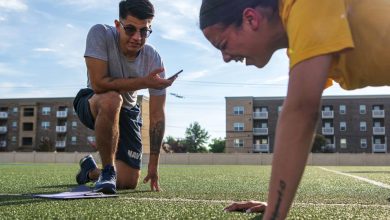What Is It And How To Avoid It 2024
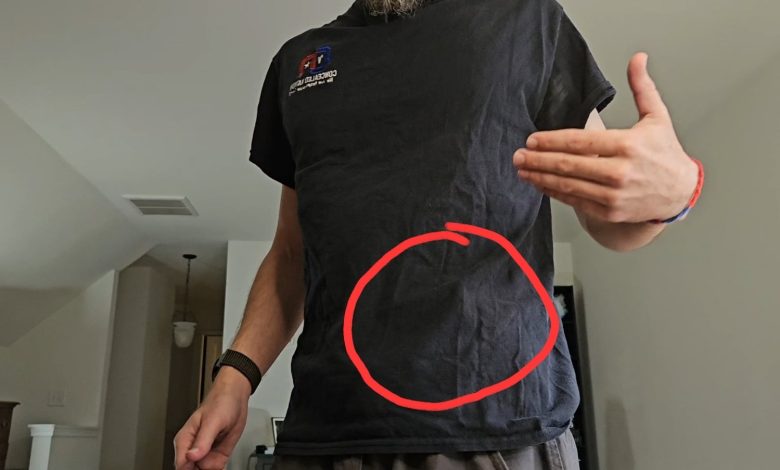
Carrying a concealed firearm (CCW) is an important responsibility, requiring not only a knowledge of firearm safety but also an understanding of how to remain discreet. One of the key challenges for concealed carriers is avoiding “printing,” a term that refers to the visible outline of a firearm through clothing. This visibility can alert others to the presence of a firearm, potentially causing unnecessary alarm or defeating the purpose of concealed carry. In this article, we will delve into what printing is and provide practical strategies to avoid it.
This guide on avoiding concealed carry printing covers all the essential aspects of responsible concealed carry. From the basics of selecting the right firearm and holster to advanced techniques and technological aids, this article provides the knowledge and tools necessary to carry discreetly and confidently.
Let’s get into answering the first question; What is printing when carrying a gun?
Understanding Concealed Carry Printing
Concealed Carry Printing when carrying a gun occurs when the outline or shape of a firearm is visible through your clothing. This can happen due to various reasons such as improper holster placement, tight or thin clothing, or an unsuitable firearm for your body type. Printing compromises the element of surprise (among other things), which is crucial in a self-defense situation. Therefore, understanding and preventing printing is essential for responsible concealed carry.
Choosing the Right Firearm And Holster to avoid Concealed Carry Printing
The first step in preventing printing when carrying a gun is selecting the right gun. Smaller, compact firearms are generally easier to conceal and less likely to print. However, the choice of firearm should also be balanced with ease of use and comfort. It’s important to handle and possibly test various models to find one that suits both your body type and personal preferences.
Factors to Consider When Choosing a Firearm
- Size and Weight: Compact and subcompact firearms are designed for easier concealment. These smaller firearms are lighter and have a reduced profile, making them less likely to print. However, ensure that the firearm is not so small that it becomes difficult to handle or shoot accurately.
- Grip Length: A shorter grip is less likely to protrude through clothing. While longer grips offer better control, they can be more challenging to conceal. Some firearms offer magazine extensions that can be added for better grip when needed.
- Barrel Length: Shorter barrels contribute to overall concealability. However, shorter barrels can impact accuracy and bullet velocity. Striking a balance between concealability and performance is key.
- Caliber: Smaller calibers (.380 ACP, 9mm) are typically easier to conceal and handle, while larger calibers (.40 S&W, .45 ACP) often mean bigger firearms and less self-defense ammo. Consider as well that 9mm rounds have come a long way, and are arguably just as good as larger handgun rounds for concealed carry.
Proper Holster Selection
Your concealed carry holster plays a significant role in how well you can conceal your firearm. Here are some key considerations:
Holster Type: There are various types of holsters, including inside-the-waistband (IWB), outside-the-waistband (OWB), ankle holsters, and shoulder holsters. IWB holsters are popular for their concealability, but they may require pants that are slightly larger at the waist.
Holster Material: Choose a holster made from quality materials that hold the firearm securely. Kydex and leather are common materials that offer good retention and durability, with Kydex now dominating the market.
Holster Position: The position of the holster on your body affects concealment, and in turn CCW printing. Common positions include the appendix (front), strong side (hip), and small of the back. Each position has its advantages and challenges; experimenting with different positions can help you find the best option for your body type and daily activities.
READ MORE: Choosing The Perfect Holster – 5 Important Factors To Consider
Types of Holsters
- Inside-the-Waistband (IWB): IWB holsters sit inside your waistband, offering excellent concealment. They require pants with a slightly larger waist size to accommodate the extra bulk. IWB holsters are highly customizable in terms of position and cant angle, making them versatile for different body types and preferences.
- Outside-the-Waistband (OWB): OWB holsters are worn outside the waistband and are generally more comfortable for extended wear. They may require a longer or untucked shirt to conceal effectively, and most often are used with a jacket to adequately keep it concealed. OWB holsters are less prone to printing when worn with appropriate clothing.
- Appendix Carry (AIWB): Appendix carry involves placing the holster at the front of the waistband, around the 12 o’clock position. This position offers quick access and excellent concealment, especially for slimmer individuals. However, it may be uncomfortable for some, particularly when sitting.
- Shoulder Holsters: Shoulder holsters distribute the weight of the firearm across the shoulders and are typically worn under a jacket. They are ideal for larger firearms and offer good concealment with appropriate outerwear.
- Ankle Holsters: Ankle holsters are used for smaller backup firearms. They are not suitable for primary carry due to slower access but offer excellent concealment for secondary firearms.
Concealed Carry Clothes to Choose
Your clothing can either help or hinder your efforts to conceal your firearm. Here are some tips to optimize your wardrobe for avoiding concealed carry printing:
Loose-Fitting Clothes: Clothes that fit too tightly can easily reveal the outline of your firearm. Opt for slightly looser clothing to help break up the outline.
Patterns and Layers: Patterns can distract the eye and make it harder to notice printing. Similarly, layering your clothing adds bulk and makes it easier to conceal a firearm.
Dress Around the Gun: When choosing your daily attire, consider your firearm and holster. This might mean choosing shirts that are long enough to cover the holster or pants with a waistband that can accommodate an IWB holster.
There are companies that specifically make concealed carry clothes, but they can also be easily recognizable to many. In the end, you don’t want to look ‘tactical’. Have you ever heard of the Grey Man Concept?
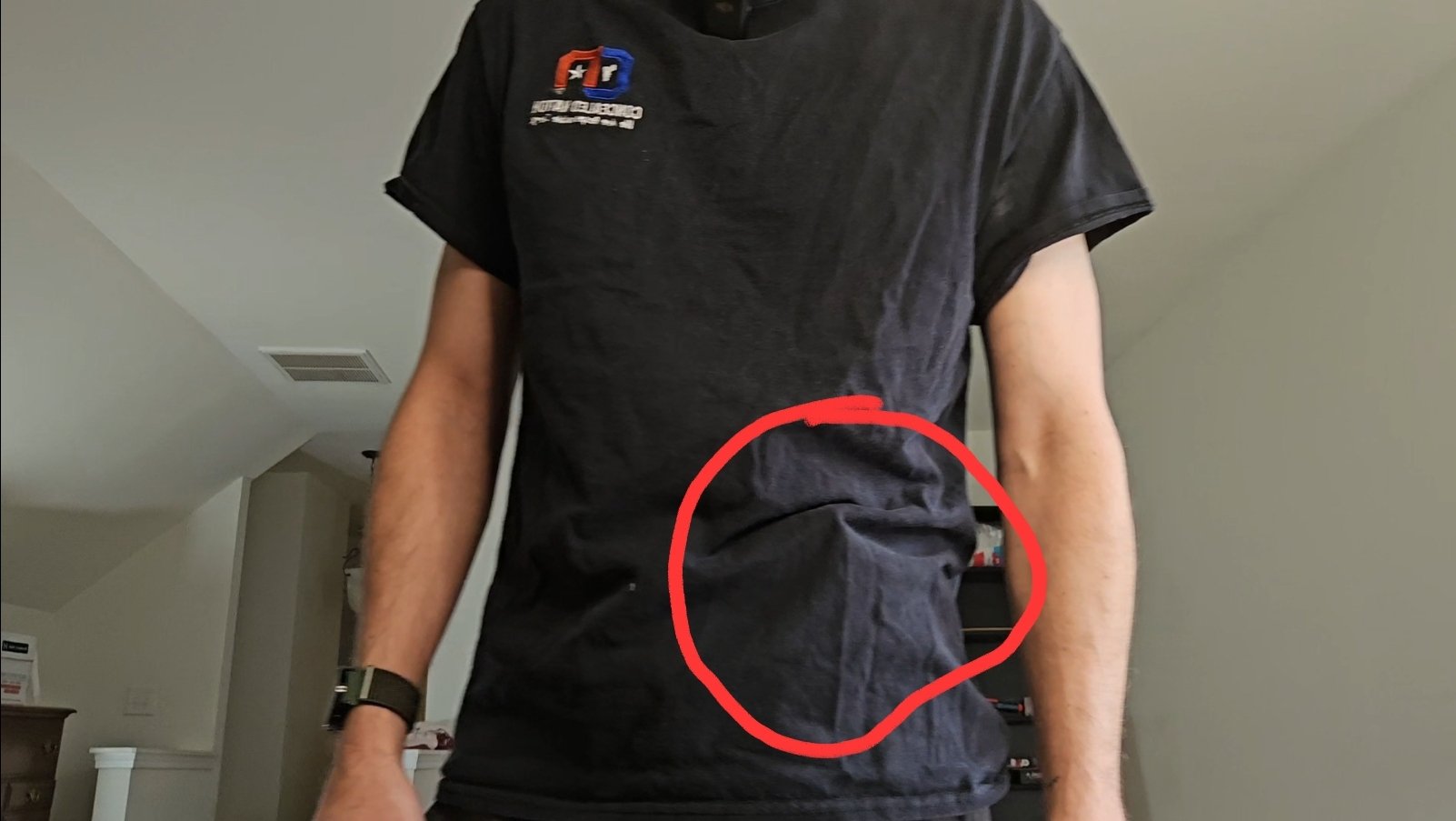
Concealed Carry Clothes Dressing Tips
- Shirts: Choose shirts that are slightly larger and made of thicker fabric to better conceal the outline of your firearm. Button-down shirts, polo shirts, and t-shirts can all be effective, depending on your style and the firearm’s position.
- Pants: Select pants that offer enough room in the waistband to accommodate an IWB holster. Consider pants specifically designed for concealed carry, which often feature reinforced waistbands and extra pockets.
- Jackets and Outerwear: Jackets, blazers, and other outerwear provide excellent cover for OWB and shoulder holsters. Ensure the outerwear is long enough to cover the holster and does not ride up when you move.
- Undergarments: Compression shirts and undershirts designed for concealed carry can help keep the firearm close to your body and reduce printing.
Body Type and Firearm Placement
Your body type will influence how and where you can effectively carry a concealed firearm. Experimenting with different positions and holsters is crucial. For instance:
Slim Build: Those with a slimmer build might find that appendix carry or ankle holsters offer better concealment.
Heavier Build: Individuals with a larger frame may benefit from strong side carry or shoulder holsters, as these can distribute the weight more comfortably and discreetly.
Tailoring Firearm Placement to Your Body Type
- Appendix Carry for Slim Builds: Appendix carry is often recommended for individuals with a slimmer build because it offers excellent concealment and quick access. The natural curvature of the abdomen helps to hide the firearm’s grip, and is ideal to help avoid concealed carry printing.
- Strong Side Carry for Larger Builds: For those with a larger midsection, carrying on the strong side (3-4 o’clock position) can be more comfortable and effective. This position takes advantage of the natural contours of the body to hide the firearm.
- Shoulder Holsters for All Body Types: Shoulder holsters can be adjusted to fit various body types and are particularly effective when wearing jackets or blazers. They distribute the weight of the firearm evenly, reducing discomfort during extended wear.
- Ankle Holsters for Secondary Carry: Ankle holsters are suitable for all body types when used for carrying a backup firearm. Ensure the holster is secure and does not impede movement.
READ MORE: 1 Year With Appendix Carry. Is It Worth The Change?
Holster Adjustments and Enhancements
Sometimes, small adjustments to your holster can make a big difference in preventing concealed carry printing. Consider these enhancements, which we also touched on above:
Cant Angle: Adjusting the cant angle of your holster can help reduce printing. A forward cant can align the grip of the firearm closer to your body.
Claw Attachments: These devices can be added to IWB holsters to push the grip of the firearm closer to the body, reducing CCW printing.
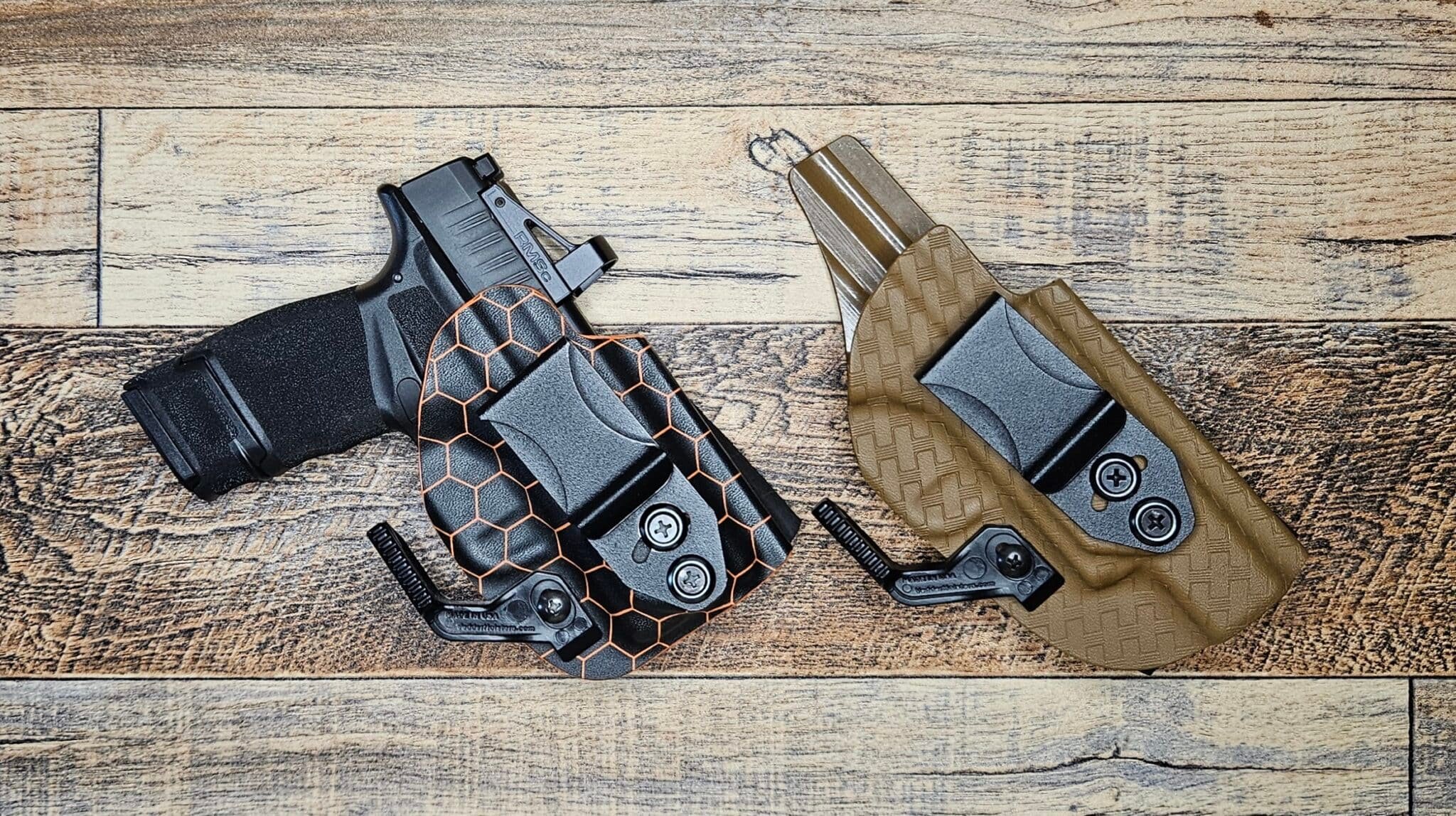
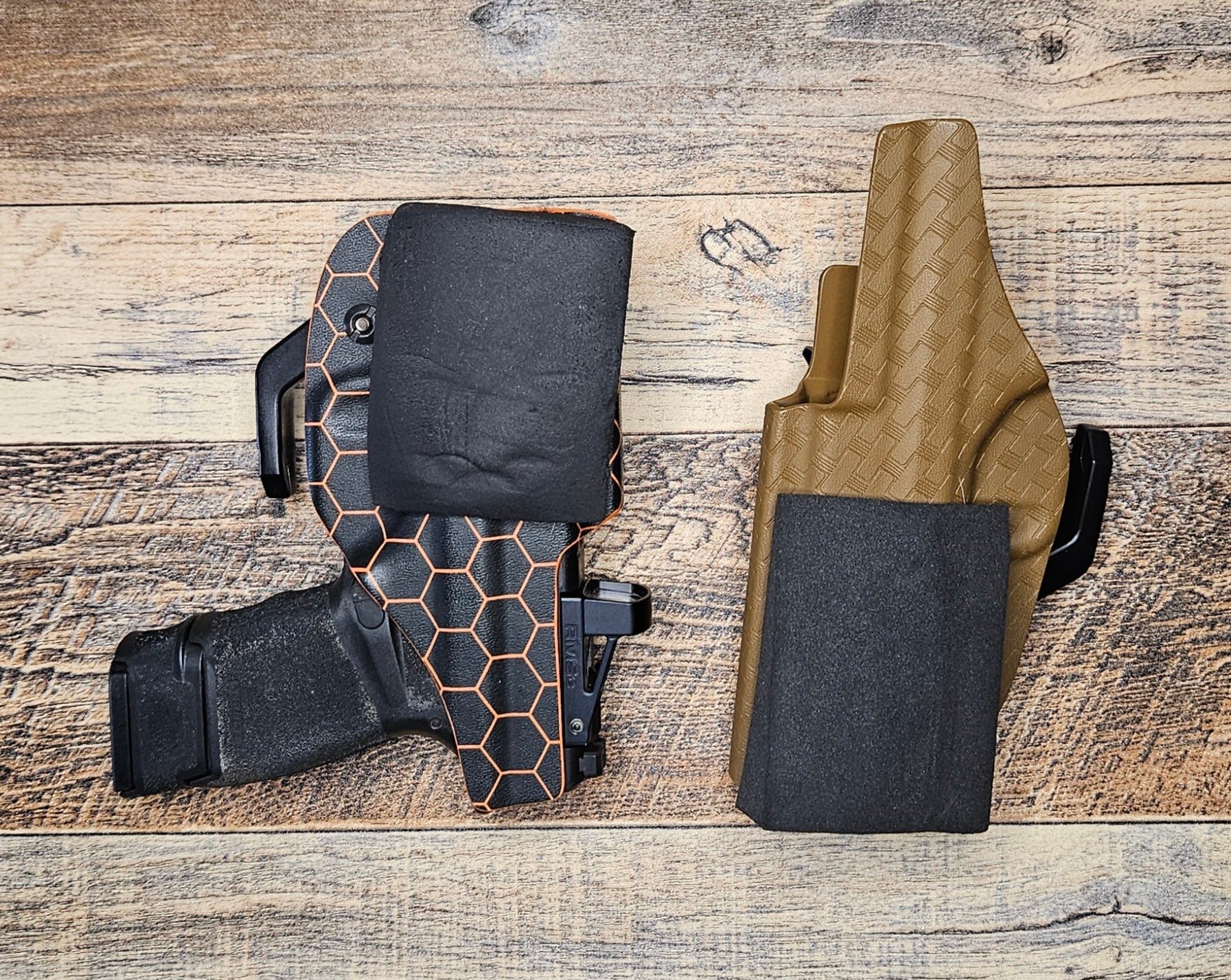
Enhancements for Improved Concealment
- Adjustable Cant Holsters: Many IWB holsters offer adjustable cant angles. Experiment with different angles to find the one that best reduces printing for your body type and carry position.
- Claw and Wing Attachments: Claw and wing attachments are designed to push the grip of the firearm inward, towards the body. These attachments are particularly useful for appendix carry, where the grip can protrude more noticeably.
- Foam Wedges: Adding a foam wedge to the bottom of your holster can help tilt the grip inward, further reducing printing. Foam wedges are inexpensive and can be easily customized to fit your holster and body shape.
- Retention Straps: Some holsters come with retention straps that secure the firearm in place. While retention straps add an extra step to the draw process, they can improve concealment by keeping the firearm snug against your body. HOWEVER, they can also make it more difficult to access your firearm should you need it.
READ MORE: Mastering Comfort and Concealment: How Holster Claws and Foam Wedges Work Together
Situational Awareness and Posture
Maintaining situational awareness and good posture can also help in avoiding printing. Slouching or bending over can cause your clothing to tighten and reveal the outline of your firearm. Being mindful of your movements and standing or sitting in a way that minimizes printing is essential.
Tips for Maintaining Concealment
- Mind Your Movements: Avoid bending or stretching in ways that could cause your clothing to tighten around your firearm. For example if you’re carrying strong side and you need to pick something up, consider squatting instead of bending at the waist.
- Check Yourself: Regularly check your reflection or use a mirror to ensure your firearm remains concealed. Make adjustments as needed throughout the day, but not in the presence of others if you’re out and about.
- Practice Proper Posture: Standing and sitting with good posture not only benefits your health but also helps keep your firearm concealed. Maintaining a straight back and avoiding slouching will help with concealed carry printing.
- Use Cover: When adjusting your firearm or holster, use cover such as a restroom or your vehicle to ensure privacy. Avoid making adjustments in public view.
Concealed Carry Belts
A sturdy concealed carry belt can make a significant difference in comfort and concealment. These belts are designed to support the weight of your firearm and holster, keeping them securely in place and reducing movement that can cause printing.
Choosing the Right Concealed Carry Belt
- Material: Concealed carry belts are typically made from reinforced leather, nylon, or other durable materials. Choose a belt that offers both rigidity and comfort.
- Width: A wider belt (1.5 inches or more) provides better support for the weight of your firearm and holster. Ensure the belt fits comfortably through your pant loops.
- Adjustability: Look for belts with multiple adjustment holes or ratcheting systems for a secure and customizable fit. This allows you to find the perfect balance between comfort and concealment.
- Durability: Invest in a high-quality belt that can withstand daily wear and tear. A durable belt ensures consistent support and reduces the likelihood of sagging over time.
Practice and Adjustment
Regular practice with your concealed carry setup is crucial. Spend time drawing your firearm from concealment and making adjustments as needed. This practice will not only improve your ability to draw quickly and efficiently but also help you identify and correct any printing issues.
Practicing Concealed Carry Techniques
- Dry Fire Practice: Practice drawing your unloaded firearm from concealment at home. Focus on smooth, consistent motions and identify any adjustments needed to improve concealment.
- Live Fire Drills: Conduct live fire drills at the range to simulate real-world scenarios. Practice drawing from concealment and engaging targets to build muscle memory and confidence.
- Holster Reholstering: Practice reholstering your firearm safely and efficiently. Ensure the holster remains secure and does not shift during the process.
- Wardrobe Testing: Experiment with different clothing combinations to find what works best for your concealment needs. Test various outfits during practice sessions to ensure they provide effective concealment.
The Importance of Responsible Concealed Carry
Carrying a concealed firearm comes with significant responsibilities. It’s not just about self-defense but also about ensuring the safety of those around you. Avoiding printing is a part of this responsibility, as it helps maintain the element of surprise and prevents unnecessary panic in public spaces.
Legal Considerations for Concealed Carry
- Understand Local Laws: Concealed carry laws vary by state and locality. Familiarize yourself with the regulations in your area to ensure you are in compliance. This includes understanding where you can and cannot carry a concealed firearm.
- Permit Requirements: Most states require a concealed carry permit. Ensure your permit is valid and up to date. Keep your permit with you whenever you are carrying your firearm.
- Training and Education: Many states require concealed carry training as part of the permit process. Even if not required, ongoing training and education are essential for responsible firearm ownership.
- Legal Defense: Consider obtaining legal defense coverage for concealed carry incidents. Organizations such as the USCCA (United States Concealed Carry Association) offer insurance and legal support for concealed carriers.
READ MORE: In-Depth Comparison Of 4 Concealed Carry Insurance, Legal Protection Companies
Conclusion
By understanding what printing is and employing these strategies to avoid it, you can carry your concealed firearm more effectively and responsibly. From choosing the right firearm and holster to making smart clothing choices, these tips will help you maintain the discretion that is essential for successful concealed carry. This responsibility extends beyond personal safety to the well-being of those around you, reinforcing the importance of being a vigilant and conscientious firearm owner.
CCW printing doesn’t need to be a thing. It’s an ongoing adventure and when you change your wardrobe, the considerations above should be taken into account. While printing isn’t the end of the world, it’s still important to maintain the element of surprise, and to not draw any unnecessary attention to yourself when out and about.
Safety Tip: Regularly inspect and maintain your holster and firearm to ensure they are in good working condition. A malfunctioning holster can compromise your concealment and safety.
Read the full article here


